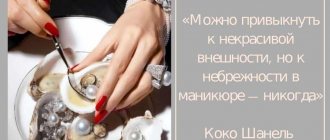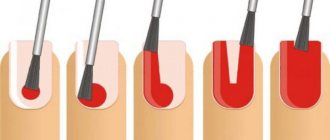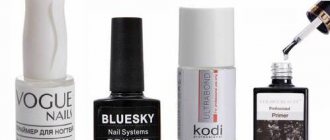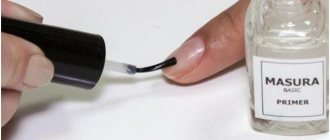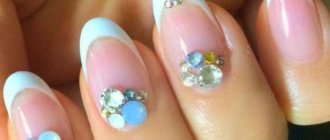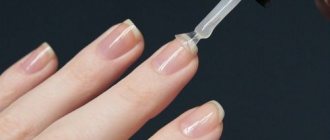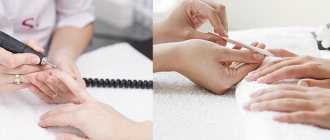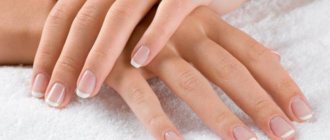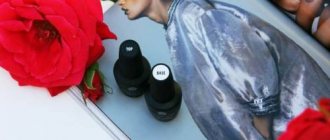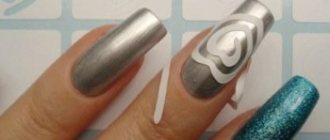Christian Dior once said that the beauty of your hands can say a lot about your style without a single word.
We are accustomed to the fact that a woman’s calling card is her face. BUT now cosmetology has come so far that any age-related change can be masked almost without a trace.
Chanel about manicure
Therefore, you can now learn more about a woman by her hands, by their degree of grooming, by a high-quality and neat manicure. This element is like a bold point in a sentence, completing the integrity of the female image.
Modern products make it possible to wear the coating on your nails for up to four weeks, allowing busy ladies to save time and visit a specialist or carry out the procedure themselves just once a month.
The most important step that directly affects the “service life” of gel coatings or acrylic extensions is the application of nail primer.
What is a nail primer?
The commercial move of manufacturers has led to the fact that on store shelves you can find primer, bonder, and nail prep. All of these are, in fact, types of primers, only slightly different in composition.
Primer – (translated from Latin as “first”, from English as “primer”) is a liquid product for preparing the nail plate for professional long-term manicure. It is designed to clean and degrease the nail surface and prevent peeling of the coating.
As a result, it enhances the adhesion or adhesion of coating materials to the nail plate. Thanks to this, not only does the durability of the manicure increase, but also the risk of the development of pathogenic microorganisms under the artificial turf is reduced - with the materials fitting as tightly as possible, there is simply no room left for the fungus on the disinfected nail.
It is important that the use of a primer prevents the deep impact of the chemical components that make up the “top layers” on the natural nail.
If you care about the thickness of the coating, then the primer does not add a millimeter to it. In professional slang, it is even called “double-sided tape,” which allows you to discreetly and reliably secure the coating even on such vulnerable areas as the ends and edges of the nails.
The Importance of Nail Primer
Externally, the packaging of the primer is identical to any type of varnish - it is an opaque bottle with a brush on the lid. When choosing a product, special attention should be paid to studying the information on the label.
How to choose the right one
The main points are simple: do not focus solely on cost. Reasonable savings are appropriate, but buying obviously cheap samples is still not worth it. In this case, there is a high risk of getting a low-quality fake and causing irreparable damage to your nails.
The product contains quite aggressive substances, but trusted manufacturers try to soften their effects by introducing caring and protective components into the mixture. Of course, this will not happen in cheap primers, so you can cause significant harm to your health.
What to look for when purchasing:
- Reputation of the outlet . Unfortunately, no one is immune from counterfeits, but reputable stores and online sites always strive to satisfy the buyer completely and carefully check the products sold. You should also not buy the product “on the run” from dubious kiosks and stalls.
- Product packaging . Despite the laconic design of most of these products, simple recommendations will help you immediately spot a fake. The slightest irregularities and asymmetry of letters and stickers, as well as easily erased inscriptions, indicate a possible counterfeit.
- Best before date . Most of us are already accustomed to monitoring the purchase of food products on this basis, but we simply forget about other categories of goods or consider this particular indicator to be unimportant. At the same time, this factor also affects the quality of the product, as well as its long “service”. Very often you can see discounts and promotions on products that are already approaching their expiration date, so be careful.
In the video, which primer to choose for gel polish:
It is advisable to give preference to products from trusted companies specializing in products for nail design. It is best to buy a primer, “starter” and “finish” coating from the same brand.
Ideally, all such products should be of a similar “pedigree,” but if funds do not allow you to purchase a complete set, it is better to save a little on a color coating that does not come into direct contact with your nails. In the case of a primer and fixer, such advice will be unsuccessful.
Types of primers by composition
The fact is that, depending on the composition, primers are divided into 3 main classes: acidic, acid-free and bond. And when choosing, you need to consider the following factors:
- condition of the nail plate;
- type of coating;
- presence of allergies to chemical components;
- frequency of procedures.
Pre-primer or bond
This type of product is the safest among all three. It does not contain aggressive chemical dyes and fragrances, it does not penetrate deep into the structure of the nail plate, drying only its top layer. Thanks to this, the bond is ideal for weakened, thin and brittle nails, and is also recommended as a practically hypoallergenic product.
BOND
Of course, such a composition does not guarantee strong adhesion to the material. Therefore, the bond is used as a degreaser when applying regular polish, gel polish, or before applying an acid/acid-free primer.
In the second case, it is more correct to call the product a pre-primer. Because it acts as an intermediate protective layer between natural nails and the primer.
Acid-free
Primer based on ethyl acetate - a hypoallergenic solvent, safe even for sensitive hands. It is often called ultrabond due to its similar gentle effect on nails.
Acid-free primer
There are a number of features of an acid-free primer:
- Safe for both the nail plate and skin. Suitable for use with dry hand skin prone to allergic reactions.
- At the same time, it degreases well, it does not affect the pH level (acidity) of the nail and does not thin it.
- Dries quickly, significantly speeding up the manicure process.
- Suitable for any work with gel coatings, from gel polish to modeling using gel.
- When dry, it does not leave a mark on the nail plate - the master focuses on the absence of wet areas on the nail.
- Does not subsequently change the color of the base coat.
Acid
Finally, the “strongest” option, which contains methacrylic acid. The packaging of such a product always contains the inscription “ACIDBASED”, that is, “acid-based”.
It is very important to understand that the acid in this primer is mildly toxic. In combination with other components, it significantly dehydrates the nail several layers deep. Therefore, it is not recommended to use it on weakened nails - this will only worsen their condition.
Acid primer
However, the acid primer has a number of undeniable advantages:
- it provides 100% strong adhesion of the material to the nail, lifting the scales of the nail plate due to severe dehydration;
- completely disinfects the nail, eliminating any possibility of infection;
- suitable for working with oily nail plates;
- recommended for hyperhidrosis (excessive sweating);
- helps to “tame” the most difficult nail shapes to work with: springboard-shaped, twisted, etc.;
- used before acrylic extensions or strengthening.
Unlike its acid-free counterpart, when it dries, it leaves a typical white coating on the nails, which indicates that the nail is ready for further work.
A significant disadvantage is the specific acidic odor, therefore, in order to avoid irritation of the mucous membrane, it is recommended to thoroughly ventilate the room while working with this product.
Another important point is that such a primer needs to be applied in a very thin, neat layer. This will minimize the aggressive effects of acid.
What to apply first: top or base?
The classic three-phase manicure system includes the use of three compositions for the design of nail plates: base, main colored gel polish, top. Only with this order of shellac distribution can you get a positive result that will look neat and remain in the same condition for more than a month.
To understand what is applied first - the base or top coat on the nails, you should find out the main functions of both types of gel polish.
The base is standardly used to prepare the nail plate for applying pigment:
- Increased adhesion of the bed to the coating;
- Preventing the penetration of the dye into the plate structure;
- Increasing the strength of the decorative coating;
- Preventing the aggressive effects of the composition on nails.
Some bases are also used to level the natural surface. They fill in the depressions and smooth out the bumps, gradually making the nails even. Because of this, the base holds better.
The top has completely different properties and functions, since it is applied not before the distribution of colored gel polish, but after such design of the nails.
The top coat basically protects the shellac from damage:
- Preventing pigment fading;
- Ensuring the elasticity of the fixed composition, preventing its breakage and chipping;
- Protection of work from aggressive substances, chemicals;
- Preventing rubbing of the coating, as a result of which all the gloss comes off and the work becomes rough, matte, and unkempt.
Both compositions must be applied in one layer, evenly distributed over the surface. When applying the top, be careful, as many solutions have a sticky layer that must be removed with a cleaner to prevent smearing of the work.
Step by step application of primer on nails
- First of all, treat the cuticles and nail folds. Push the cuticle away from the nail plate with a wooden orange stick or a special metal pusher. Then remove excess skin with nail scissors/tweezers or a special cutter if you are using a manicure machine.
- Using a special file (buff, grinder), carefully sand the surface of the nail, removing the layer of natural shine.
- Clean your nails from any dust that has formed, first with a brush or brush, then with a lint-free cloth soaked in a disinfectant.
Nail preparation - Then apply primer. To do this, carefully “squeeze” the brush against the edges of the bottle, removing excess product. Apply the brush to the center of the nail and allow the degreaser to spread over the surface on its own. Carefully cover unaffected areas with a thin layer, avoiding contact with the skin. “Seal” the tip of the nail.
If correction is in progress and a thin layer of uncut base remains on the plate, then the primer is applied only to the regrown part of the natural nail.
If the primer does get on the cuticle or side ridges, then you need to thoroughly rinse the skin with water.
Primer application
Remember that the thinner the primer layer, the higher its effectiveness. The thick layer prevents the scales of the nail plate from rising higher and adhering to the artificial surface as much as possible.
- The primer air dries in 15 to 60 seconds. Next, you need to wait for the primer to air dry. How to determine that the material has dried and is ready for further work, see the description of acidic and acid-free primers above.
In rare cases, if indicated in the instructions, drying under a UV lamp is required.
- Next, proceed to covering or building up
Completing the manicure
The Best Acid-Free Primers
The most popular acid-free primers:
- Popular acid-free primer "Bluesky". The primer effectively holds gel and acrylic material on the nail plate. When using, drying under a lamp is not required. Apply the product in a minimal layer to allow the product to dry better. If after a minute it has not dried, blot the nail plate with a dry cloth. Before treating your nails with decorative material, you should wait until the primer has completely dried. The Bluesky structure has an oil base and does not have a strong aroma. Mainly used before applying base.
- For thorough preparation for a manicure, Luxio is suitable . The primer differs from analogues in its high characteristics, but costs almost 1,300 rubles.
- American-made Cuccio is an effective nail primer . The advantage is an affordable pricing policy, the primer costs 600-650 rubles.
- The liquid from China is quite cheap - only 200-220 rubles. Despite the low price, the product is highly effective, can degrease, disinfect, and effectively adheres to nail surfaces. Disadvantages - an inconvenient brush for application, as well as a strong unpleasant aroma.
- Acid-free primer "Kodi" is at the top of the ranking of top products . Buyers speak well of the composition, reliability, fairly affordable cost, and convenient method of application. The product line of this brand also includes acid primers.
What can replace the primer?
Like everything you need, the primer tends to run out at the most inopportune moment. In such situations, it is urgently necessary to replace it with a product whose properties will be close to the original version.
These often include the following:
- nail polish remover containing acetone, but without oils;
- alcohol or cologne;
- table vinegar.
Any of these homemade alternatives can dry out the surface of the nail, but none of them guarantee the result that the primer gives. Therefore, for a high-quality manicure, you should always have a specialized product.
Rating and review of top 10 primers
TOP 1. Ultrabond Cody
The most popular acid-free primer from the USA among craftsmen. Volume 12 ml. An absolutely harmless product, more like water. Practical odorless. Allows you to wear gel coating for up to 4 weeks. One package is enough for at least six months of regular use.
Ultrabond Cody
TOP 2. Primer CND.
This is a unique acid-free primer from one of the leading American ones. Volume 15 ml. Despite the absence of acids, it is suitable for acrylic coatings. Effective for both manicure and pedicure. A reliable and economical option for those who value quality.
Primer CND
TOP 3. Ultrabond Naomi.
Acid-free primer made in the USA. Volume 12 ml. It is characterized by the presence of a sticky layer that provides better adhesion of the coating and the nail plate. Does not have a strong chemical smell. Dries in seconds.
Ultrabond Naomi
TOP 4. Primer RuNail.
Domestic acid-free primer. Volume 15 ml. Thanks to the special formula, ACID FREE ensures gentle and strong adhesion of the nail to the artificial coating. Minimizes the occurrence of chipping and detachment. Does not cause allergies or irritation.
Primer RuNail
TOP 5. Primer TNL.
This is an acid-free primer made in South Korea. Volume 15 ml. Performs not only the main function of degreasing the nail plate, but also leveling microcracks, protecting the nail from deep penetration of the artificial coating. It has a pungent odor, but dissipates quickly.
Primer TNL
TOP 6. Primer Formula Pro.
A Russian bond that combines two qualities: the best adhesion in its segment and the absence of methacrylic acid. The result is an ideal coating without chips or peeling, preserving the natural color of the nail and protecting it from delamination.
Primer Formula Pro
TOP 7. Dona Jerdona.
Acid primer made in the USA. Volume is only 10 ml. Very economical - it allows you to treat 3 nails at a time, which justifies the small volume. Does not require polymerization and is suitable for any manicure technology.
Dona Jerdona
TOP 8. Mozart House.
Acid-free primer of Austrian-German production. Volume 10 ml. Users are distinguished not only by the bright design, but also by the comfortable thin brush. The bottle is spill-proof and therefore suitable for transportation. Hypoallergenic and does not cause irritation.
Mozart House
TOP 9. PRIMER BLUESKY.
A Chinese acid-free primer that confidently occupies a significant niche in the market. Contrary to expectations, it is even suitable for hands suffering from hyperhidrosis. A convenient synthetic brush ensures even distribution of the product over the surface of the nail. Has a specific smell.
PRIMER BLUESKY
TOP 10. CANNI Primer.
CANNI Primer
Another acid-free primer from the Middle Kingdom. It is mainly used in non-professional home manicures, as it perfectly fixes decorative gel polishes and allows the manicure to maintain its original appearance for up to 2 weeks. The small volume (7.3 ml) is compensated by low consumption.
